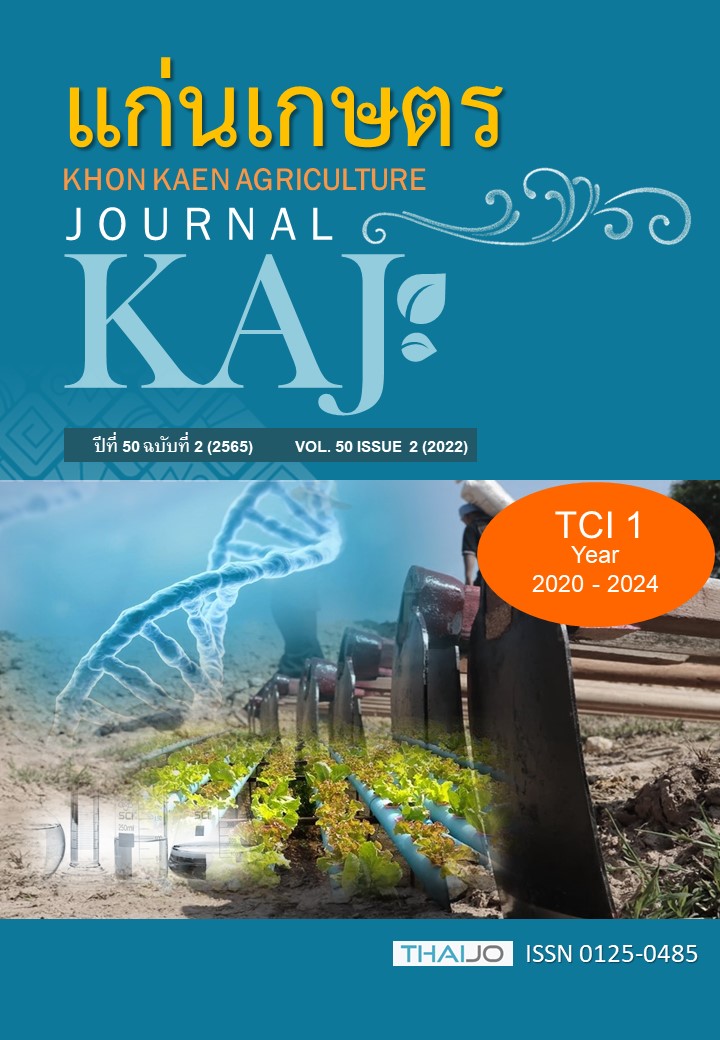ผลของอาหารในท้องถิ่นต่อสมรรถนะการผลิตและองค์ประกอบทางโภชนะของจิ้งหรีด
Main Article Content
บทคัดย่อ
การศึกษาครั้งนี้มีวัตถุประสงค์เพื่อศึกษาผลของวัตถุดิบอาหารในท้องถิ่นต่อสมรรถนะการผลิตและคุณค่าทางโภชนะของจิ้งหรีดพันธุ์ทองดำ(Gryllus bimaculatus De Geer) โดยทรีทเมนต์ที่ทำการศึกษามี 5 ทรีทเมนต์ประกอบด้วย ทรีทเมนต์ที่ 1 อาหารผสมกากถั่วเหลือง 30 % (โปรตีน 21.0%) ทรีทเมนต์ที่ 2 อาหารผสมกากถั่วเหลือง 15% + ใบมันสำปะหลังบด 15 % (โปรตีน 18.0%) ทรีทเมนต์ที่ 3 อาหารผสมใบมันสำปะหลังบด 30 % (โปรตีน 15.0%) ทรีทเมนต์ที่ 4 อาหารผสมกากถั่วเหลือง 15% + ใบหม่อนบด 15 % (โปรตีน 18.0 %) ทรีทเมนต์ที่ 5 อาหารผสมใบหม่อนบด 30 % (โปรตีน15.0%) โดยใช้แผนการศึกษาแบบสุ่มสมบูรณ์ (Completely Randomized Design, CRD) ผลการศึกษาพบว่าอัตราส่วนการเปลี่ยนอาหารเป็นน้ำหนักและอัตราการมีชีวิตรอดไม่แตกต่างกันทางสถิติ (P>0.05) ต้นทุนด้านอาหารต่อน้ำหนักตัวที่เพิ่มขึ้นมีค่าต่ำที่สุดในจิ้งหรีดที่ได้รับอาหารผสมใบมันสำปะหลังบด 30% และใบหม่อนบด 30% (P<0.05) จิ้งหรีดที่เลี้ยงด้วยอาหารผสมกากถั่วเหลือง 30 % มีระดับโปรตีนและไขมันสูงที่สุด คือ 76.2% และ 14.8% ตามลำดับ (P<0.05) และจิ้งหรีดในกลุ่มที่ได้รับอาหารผสมใบหม่อนบดที่ระดับ 15 และ 30 % มีระดับวิตามินบี 2 และ บี 12 สูงที่สุด (P<0.05) นอกจากนี้จิ้งหรีดกลุ่มที่ได้รับอาหารผสมกากถั่วเหลือง 30% มีปริมาณแร่ธาตุฟอสฟอรัส โพแทสเซียม และโซเดียมสูงที่สุด (P<0.05) ดังนั้นการใช้ใบมันสำปะหลังบดและใบหม่อนบดทดแทนกากถั่วเหลืองในอาหารที่ระดับ 30% ช่วยลดต้นทุนด้านอาหารในการผลิตจิ้งหรีด ทธิภาพการผลิตของจิ้งหรีด
Article Details

อนุญาตภายใต้เงื่อนไข Creative Commons Attribution-NonCommercial-NoDerivatives 4.0 International License.
เอกสารอ้างอิง
ทัศนีย์ แจ่มจรรยา, ชาญชัย ถาวรอนุกูลกิจ และพิษณุ อุตตมะเวทิน. 2547. การผลิตแมลงกินได้เพื่อเศรษฐกิจและโภชนาการชุมชน: จิ้งหรีด. สาขาวิชากีฏวิทยา คณะเกษตรศาสตร์ และภาควิชาโภชนวิทยา คณะสาธารณสุขศาสตร์ มหาวิทยาลัยขอนแก่น.
ประทุมพร คำภาสุข และ เยาวรัตน์ ศรีวรานันท์. 2557. การจัดการการผลิต และการตลาดของฟาร์มจิ้งหรีด ในเขตพื้นที่จังหวัดขอนแก่น กาฬสินธุ์ และมหาสารคาม. วารสารแก่นเกษตร 42: 547-554.
AOAC International. 2016. Official method of analysis, 19th ed. Association of Official Analytical Chemists, Washington, DC.
Ayieko, M., H. Ogola, and I. Ayieko. 2016. Introducing rearing crickets (gryllids) at household levels: adoption, processing and nutritional values. Journal of Insects Food and Feed. 2: 203–211.
Bawa, M., S. Songsermpong, C. Kaewtapee, and W. Chanput. 2020. Effect of diet on the growth performance, feed conversion, and nutrient content of the house cricket. Journal of Insect Science. 20: 1-10.
Brand-Williams, W., M.E. Cuvelier, and C. Berset. 1995. Use of a free radical method to evaluate antioxidant activity. Food Science and Technology. 28: 25-30.
FAO.2002. Food energy – methods of analysis and conversion factors. Available: http://www.fao.org/3/y5022e/y5022e00.htm. Accessed Dec. 30, 2020.
Food and Agriculture Organization of the United Nations (FAO)/World Health Organization (WHO). 2017. The state of food security and nutrition in the world 2017. Building resilience for peace and food security. FAO, Rome, Italy.
Giménez, E. C., and F. Martin. 2018. Vitamin B12 (cyanocobalamin) in infant formula adult/pediatric nutritional formula by liquid chromatography with ultraviolet detection: collaborative study, final action 2014.02. Journal of AOAC International. 101: 1112–1118.
Hanboonsong, Y., T. Jamjanya, and P. Durst. 2013. Six-legged livestock: edible insect farming, collection on and marketing in Thailand. Bangkok, Thailand.
Lall, D., S.S. Dahiya, T.R. Chavhan, and B.S. Puniya. 2002. Utilization of certain essential minerals in buffalo calves fed on farm ration. Indian Journal of Animal Nutrition. 19: 204–209.
Lee Y.H., C. Choo, M.I. Watawana, N. Jayawardena, and V.Y. Waisundara. 2015. An appraisal of eighteen commonly consumed edible plants as functional food based on their antioxidant and starch hydrolase inhibitory activities. Journal of Science Food and Agriculture. 95: 2956-2964.
Mattia, C.D., A. Battista, G. Saxxhetti, and M. Serafini. 2019. Antioxidant Activities in vitro of Water and Liposoluble Extracts Obtained by Different Species of Edible Insects and Invertebrates. Frontiers in Nutrition. 6: 106.
Oonincx, D., S. Laurent, M. Veenenbos, and J. Loon. 2019. Dietary enrichment of edible insects with omega 3 fatty acids. Insect Science. 27: 500-509.
Oonincx, D.G., S. Van Broekhoven, A. Van Huis, and J.J. Van Loon. 2015. Feed conversion, survival and development, and composition of four insect species on diets composed of food by-products. PLoS One. 10: e0144601.
Orinda, M. A., R.O. Mosi, M.A. Ayieko, and F. Amimo. 2017. Growth performance of common house cricket (Acheta domesticus) and field cricket (Gryllus bimaculatus) crickets fed on agro-byproducts. Journal of Entomology Zoology Studies. 5: 1664–1668.
Salvati, L. M., S.C. McClure, T.M. Reddy, and N.A. Cellar. 2016. Simultaneous determination of total vitamins B1, B2, B3, and B6 in infant formula and related nutritionals by enzymatic digestion and LC-MS/ MS: single-laboratory validation, first action 2015.14. Journal of AOAC International. 99: 776-785.
SAS. 2013. What’s New in SAS® 90, 91, 912, and 913 Cary, NC: SAS Institute Inc.
Tan, N.D., M. Wanapat, S. Uriyapongson, A. cherdthong, and R. Pilajun. 2012. Enhancing mulberry leaf meal with urea by pelleting to improve rumen fermentation in cattle. Asian Australasian Journal of Animal Science. 25(4): 452-461.
Veenenbos, M., and D. Oonincx. 2017. Carrot supplementation does not affect house cricket performance (Acheta domesticus). Journal of Insects Food and Feed. 3: 217-221.
Wanapat, M., K. Phesatcha, B. Viennaxay, B. Phesatcha, T. Ampapon, and S. Kang. 2018. Strategic supplementation of cassava top silage to enhance rumen fermentation and milk production in lactating dairy cows in the tropics. Tropical Animal Health and Production. 50: 1539-1546.


